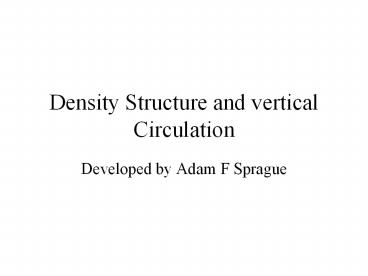Density Structure and vertical Circulation - PowerPoint PPT Presentation
1 / 10
Title:
Density Structure and vertical Circulation
Description:
A zone where temperature changes rapidly with depth is called a thermocline. ... The main thermocline exists year-round and begins at about 100 m, extending ... – PowerPoint PPT presentation
Number of Views:237
Avg rating:3.0/5.0
Title: Density Structure and vertical Circulation
1
Density Structure and vertical Circulation
- Developed by Adam F Sprague
2
2.The density (mass/volume ratio) of seawater is
controlled by its salinity and its temperature.
- Seawater density increases as salinity increases
density decreases as temperature increases
density increases as pressure increases. - Processes that increase the salinity of seawater
include evaporation and the formation of sea ice.
3
In surface water of the open oceans, geographic
patterns in salinity are controlled by the
evaporation/precipitation ratio .
- Surface water salinity is highest in the desert
latitudes of 20-30 N and 10-30 S. - Surface water salinity is lowest near the equator
(5 N), because of the high precipitation there,
and also at most locations with latitude gt 40.
In those areas precipitation may be high (e.g.,
around 50-60), but low evaporation due to low
temperature is also a factor.
4
In the surface water of the open oceans,
geographic patterns in density are controlled by
the temperature of surface waters
- Density in surface waters is not controlled by
salinity. This is because the salinity of open
ocean water varies relatively little compared to
temperature. - Temperature of the ocean surface waters decreases
with increasing latitude, due to decreased solar
energy input
5
2.Generally the density of ocean water increases
with depth.
- Usually, the increase in density with depth is
because of a decrease in temperature with depth.
In this case, the water column is stable. - A stable water column does not mix vertically
unless acted on by outside forces (for example,
winds). - Vertical mixing means random exchange of water
between depths. It is different from upwelling
and downwelling, which are upward and downward
flow of water.
6
3. If the density of water decreases with depth,
the water column is unstable.
- Usually an unstable water column occurs because
surface water cools and becomes more dense. Less
commonly, evaporation causes increased salinity
and thus increased density of surface water. In
the polar regions, sea ice formation increases
surface water salinity and leads to instability
7
4. There is a seasonal variation in the amount of
solar radiation the ocean receives (except in the
tropics).
- This results in a seasonal variation in water
column stability and mixing
8
5. In most of the ocean a warm, less-dense
surface layer overlies colder, denser subsurface
water
- There is usually a fairly sharp boundary between
this surface layer and the deeper waters. - In the boundary, density and temperature change
rapidly with depth. - This zone where density changes rapidly with
depth is called a pycnocline. - A zone where temperature changes rapidly with
depth is called a thermocline. - A zone where salinity changes rapidly with depth
is called a halocline.
9
There are two major thermoclines (and
pycnoclines) in many areas of the ocean
- The main thermocline exists year-round and begins
at about 100 m, extending below 500 m depth. Its
upper boundary corresponds to the depth of mixing
in winter. - The seasonal thermocline is shallower (20-50 m
depth in most cases), and is present only in
warmer months when heating of surface water makes
it less dense.
10
6. Oceanographers often represent the properties
of ocean water in graphs which show a vertical
cross-section of an area of the ocean.
- The properties are plotted as lines of constant
value, for example - Isopycnals are lines of constant density. They
show the position of water layers that have
uniform density. - Isotherms are lines of constant temperature. They
show the position of water layers of uniform
temperature.































